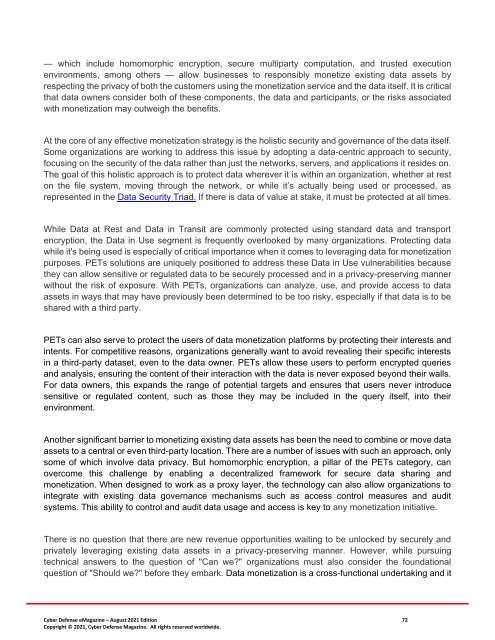Cyber Defense eMagazine August Edition for 2021
Cyber Defense eMagazine August Edition for 2021 #CDM #CYBERDEFENSEMAG @CyberDefenseMag by @Miliefsky a world-renowned cyber security expert and the Publisher of Cyber Defense Magazine as part of the Cyber Defense Media Group as well as Yan Ross, US Editor-in-Chief, Pieruligi Paganini, Co-founder & International Editor-in-Chief, Stevin Miliefsky, President and many more writers, partners and supporters who make this an awesome publication! Thank you all and to our readers! OSINT ROCKS! #CDM #CDMG #OSINT #CYBERSECURITY #INFOSEC #BEST #PRACTICES #TIPS #TECHNIQUES
Cyber Defense eMagazine August Edition for 2021 #CDM #CYBERDEFENSEMAG @CyberDefenseMag by @Miliefsky a world-renowned cyber security expert and the Publisher of Cyber Defense Magazine as part of the Cyber Defense Media Group as well as Yan Ross, US Editor-in-Chief, Pieruligi Paganini, Co-founder & International Editor-in-Chief, Stevin Miliefsky, President and many more writers, partners and supporters who make this an awesome publication! Thank you all and to our readers! OSINT ROCKS! #CDM #CDMG #OSINT #CYBERSECURITY #INFOSEC #BEST #PRACTICES #TIPS #TECHNIQUES
You also want an ePaper? Increase the reach of your titles
YUMPU automatically turns print PDFs into web optimized ePapers that Google loves.
— which include homomorphic encryption, secure multiparty computation, and trusted execution<br />
environments, among others — allow businesses to responsibly monetize existing data assets by<br />
respecting the privacy of both the customers using the monetization service and the data itself. It is critical<br />
that data owners consider both of these components, the data and participants, or the risks associated<br />
with monetization may outweigh the benefits.<br />
At the core of any effective monetization strategy is the holistic security and governance of the data itself.<br />
Some organizations are working to address this issue by adopting a data-centric approach to security,<br />
focusing on the security of the data rather than just the networks, servers, and applications it resides on.<br />
The goal of this holistic approach is to protect data wherever it is within an organization, whether at rest<br />
on the file system, moving through the network, or while it’s actually being used or processed, as<br />
represented in the Data Security Triad. If there is data of value at stake, it must be protected at all times.<br />
While Data at Rest and Data in Transit are commonly protected using standard data and transport<br />
encryption, the Data in Use segment is frequently overlooked by many organizations. Protecting data<br />
while it's being used is especially of critical importance when it comes to leveraging data <strong>for</strong> monetization<br />
purposes. PETs solutions are uniquely positioned to address these Data in Use vulnerabilities because<br />
they can allow sensitive or regulated data to be securely processed and in a privacy-preserving manner<br />
without the risk of exposure. With PETs, organizations can analyze, use, and provide access to data<br />
assets in ways that may have previously been determined to be too risky, especially if that data is to be<br />
shared with a third party.<br />
PETs can also serve to protect the users of data monetization plat<strong>for</strong>ms by protecting their interests and<br />
intents. For competitive reasons, organizations generally want to avoid revealing their specific interests<br />
in a third-party dataset, even to the data owner. PETs allow these users to per<strong>for</strong>m encrypted queries<br />
and analysis, ensuring the content of their interaction with the data is never exposed beyond their walls.<br />
For data owners, this expands the range of potential targets and ensures that users never introduce<br />
sensitive or regulated content, such as those they may be included in the query itself, into their<br />
environment.<br />
Another significant barrier to monetizing existing data assets has been the need to combine or move data<br />
assets to a central or even third-party location. There are a number of issues with such an approach, only<br />
some of which involve data privacy. But homomorphic encryption, a pillar of the PETs category, can<br />
overcome this challenge by enabling a decentralized framework <strong>for</strong> secure data sharing and<br />
monetization. When designed to work as a proxy layer, the technology can also allow organizations to<br />
integrate with existing data governance mechanisms such as access control measures and audit<br />
systems. This ability to control and audit data usage and access is key to any monetization initiative.<br />
There is no question that there are new revenue opportunities waiting to be unlocked by securely and<br />
privately leveraging existing data assets in a privacy-preserving manner. However, while pursuing<br />
technical answers to the question of "Can we?" organizations must also consider the foundational<br />
question of "Should we?" be<strong>for</strong>e they embark. Data monetization is a cross-functional undertaking and it<br />
<strong>Cyber</strong> <strong>Defense</strong> <strong>eMagazine</strong> – <strong>August</strong> <strong>2021</strong> <strong>Edition</strong> 72<br />
Copyright © <strong>2021</strong>, <strong>Cyber</strong> <strong>Defense</strong> Magazine. All rights reserved worldwide.


















